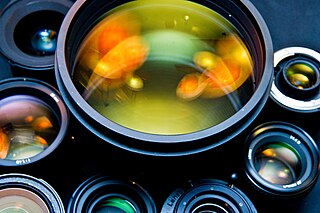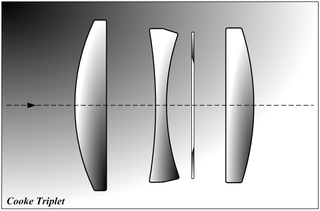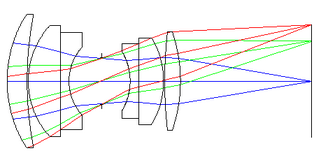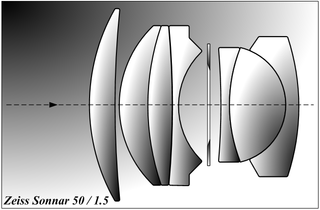
A camera lens is an optical lens or assembly of lenses used in conjunction with a camera body and mechanism to make images of objects either on photographic film or on other media capable of storing an image chemically or electronically.

The Cooke triplet is a photographic lens designed and patented in 1893 by Dennis Taylor who was employed as chief engineer by T. Cooke & Sons of York. It was the first lens system that allowed elimination of most of the optical distortion or aberration at the outer edge of the image.

A telephoto lens, also known as telelens, is a specific type of a long-focus lens used in photography and cinematography, in which the physical length of the lens is shorter than the focal length. This is achieved by incorporating a special lens group known as a telephoto group that extends the light path to create a long-focus lens in a much shorter overall design. The angle of view and other effects of long-focus lenses are the same for telephoto lenses of the same specified focal length. Long-focal-length lenses are often informally referred to as telephoto lenses, although this is technically incorrect: a telephoto lens specifically incorporates the telephoto group.

The Angénieux retrofocus photographic lens is a wide-angle lens design that uses an inverted telephoto configuration. The popularity of this lens design made the name retrofocus synonymous with this type of lens. The Angénieux retrofocus for still cameras was introduced in France in 1950 by Pierre Angénieux.

A zoom lens is a system of camera lens elements for which the focal length can be varied, as opposed to a fixed-focal-length (FFL) lens.

Voigtländer was a significant long-established company within the optics and photographic industry, headquartered in Braunschweig, Germany, and today continues as a trademark for a range of photographic products.

A catadioptric optical system is one where refraction and reflection are combined in an optical system, usually via lenses (dioptrics) and curved mirrors (catoptrics). Catadioptric combinations are used in focusing systems such as searchlights, headlamps, early lighthouse focusing systems, optical telescopes, microscopes, and telephoto lenses. Other optical systems that use lenses and mirrors are also referred to as "catadioptric", such as surveillance catadioptric sensors.

The Maksutov is a catadioptric telescope design that combines a spherical mirror with a weakly negative meniscus lens in a design that takes advantage of all the surfaces being nearly "spherically symmetrical". The negative lens is usually full diameter and placed at the entrance pupil of the telescope. The design corrects the problems of off-axis aberrations such as coma found in reflecting telescopes while also correcting chromatic aberration. It was patented in 1941 by Soviet optician Dmitri Dmitrievich Maksutov. Maksutov based his design on the idea behind the Schmidt camera of using the spherical errors of a negative lens to correct the opposite errors in a spherical primary mirror. The design is most commonly seen in a Cassegrain variation, with an integrated secondary, that can use all-spherical elements, thereby simplifying fabrication. Maksutov telescopes have been sold on the amateur market since the 1950s.
Cooke Optics Ltd. is a camera lens manufacturing company based in Leicester.

The double Gauss lens is a compound lens used mostly in camera lenses that reduces optical aberrations over a large focal plane.

The Zeiss Sonnar is a photographic lens originally designed by Dr. Ludwig Bertele in 1929 and patented by Zeiss Ikon. It was notable for its relatively light weight, simple design and fast aperture.
Walter Mandler was a lens designer of Ernst Leitz Canada in Midland, Ontario. Mandler is credited with the design of more than 45 Leica lenses for the Leica rangefinder cameras and Leica SLR cameras.
A dialyte lens is a compound lens design that corrects optical aberrations where the lens elements are widely air-spaced. The design is used to save on the amount of glass used for specific elements or where elements can not be cemented because they have dissimilar curvatures. The word dialyte means "parted", "loose" or "separated".

An anastigmat or anastigmatic lens is a photographic lens completely corrected for the three main optical aberrations: spherical aberration, coma, and astigmatism. Early lenses often included the word Anastigmat in their name to advertise this new feature.

The Gauss lens is a compound achromatic lens that uses two uncemented elements; in its most basic form, a positive meniscus lens on the object side and a negative meniscus lens on the image side. It was first proposed in 1817 by the mathematician Carl Friedrich Gauss for a refracting telescope design, but was seldom implemented and is better known as the basis for the Double-Gauss lens first proposed in 1888 by Alvan Graham Clark, which is a four-element, four-group compound lens that uses a symmetric pair of Gauss lenses.
The design of photographic lenses for use in still or cine cameras is intended to produce a lens that yields the most acceptable rendition of the subject being photographed within a range of constraints that include cost, weight and materials. For many other optical devices such as telescopes, microscopes and theodolites where the visual image is observed but often not recorded the design can often be significantly simpler than is the case in a camera where every image is captured on film or image sensor and can be subject to detailed scrutiny at a later stage. Photographic lenses also include those used in enlargers and projectors.

Ludwig Jakob Bertele was a German optics constructor. His developments received universal recognition and serve as a basis for considerable part of the optical designs used today.

The invention of the camera in the early 19th century led to an array of lens designs intended for photography. The problems of photographic lens design, creating a lens for a task that would cover a large, flat image plane, were well known even before the invention of photography due to the development of lenses to work with the focal plane of the camera obscura.

Rodenstock Photo Optics traces its origins to a mechanical workshop founded in 1877 by Josef Rodenstock and his brother Michael in Würzburg, Germany. The company relocated to Munich by 1884 and became an important manufacturer of both corrective lenses for glasses and camera lenses by the early 1900s. These two lines began to diverge in the 1960s as the center of photographic lens manufacturing shifted to Japan; the ophthalmic business continued as Rodenstock GmbH while the remaining camera lens business was repositioned to serve the large format and industrial precision optics markets, then spun off in 1996 as Rodenstock Präzisionsoptik. Since then, the precision optics brand has been acquired in succession by LINOS Photonics, Qioptiq Group, and Excelitas Technologies (2013).















